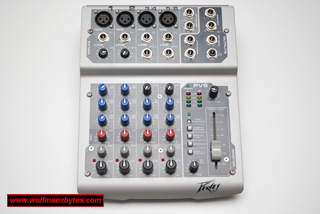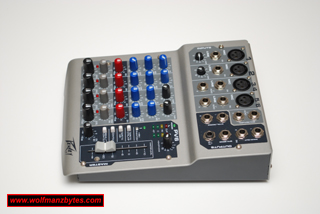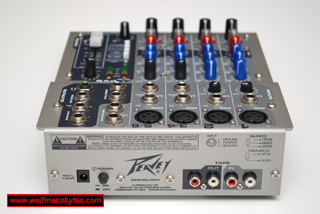
Today I take a look at the Peavey PV6 mixer and see what all this little mixer has to offer.
Before I get too far into this review I should mention the features and specs of the Peavey PV6 and they are the following.
Features..
- XLR Mic inputs on all four channels
- Two Stereo channels with 1/4" inputs
- Three-band EQ on mono channels
- Two-band EQ on stereo channels
- Clip LEDs that thoroughly monitor clipping
- 48V phantom power switch
- Effects send on every channel with stereo return
- Zero latency record monitoring capabilities
- Control room out with level control
- Contour control switch
- 80 Hz low cut switch
Specifications..
- Weight Unpacked: 5.30 lb(2.404 kg)
- Weight Packed: 7.00 lb(3.175 kg)
- Width Packed: 4.25"(10.795 cm)
- Depth Packed: 15.25"(38.735 cm)
- Height Packed: 10.25"(26.035 cm)
One thing to keep in mind about the PV6 is there are two versions of the mixer on the market. The version I have here is the one without the USB connection on it. As far as I can tell the only difference between the two PV6 models is the USB option and in every other way they are the same.
I purchased the PV6 a while ago when I needed a mixer for a computer sound card I had. At the time I wanted to run some Phantom Powered mics into my computer’s sound card but didn’t have the connections to do so on the sound card, so I started to hunt around for a small mixer that could accomplish this task and that’s when I found the Peavey PV6.
This mixer can be used for all sorts of things but what I’m currently using it for right now is to feed my phantom powered mics into the line in on the video camera I have that I use for the Youtube reviews I record. I use the tape out jacks on the back of the PV6 and feed them into the video camera’s line in, and with that I can use whatever mics I want to with the video camera or even use multiple mics at the same time.
For those that don’t know what Phantom Power means, there are basically two types of mics that you can use with a mixer like the PV6. Your first type is your standard mic that plugs in and don’t require any sort of power to operate and an example of a mic like that would be a SM58. The second type of mic is known as a condenser mic and these have built in preamps that require a power source and they get that power from the mic cable via a mixer that supports Phantom Power.
The first thing you notice about the PV6 when you unbox this thing is that the entire unit is made from pretty thick gauge metal which means it’s got a weighty / solid feel to it. The next thing you notice is the slick look this mixer has to it. The metal surface has a nice paint job and from a looks point of view the entire mixer looks really good.
In the picture below you can see that each channel strip has level and balance controls along with some EQ controls. One of the more interesting controls on each of the channel’s is the EFX dial and that allows you to control how much of a signal you’re getting back from the EFX returns on the PV6. So for example let’s say you have an external reverb unit, you could hook its left and right outputs into the EFX returns on the PV6 and then you take the EFX send from the PV6 and put that into the reverb’s input. This allows you to control how much reverb each of the channel strips would get on the PV6 from the external reverb unit and that’s a pretty cool feature to have.
When you move to the top of the PV6 you can see the quarter inch input jacks and then above that you have your female XLR input jacks. All the channels on the PV6 have gain controls and level controls and that’s good for giving you’re the right amount control. Channels 3-4 and 5-6 also come equipped with line level stereo inputs. These inputs are good for running line level outputs like that of a CD player into the PV6.
When you look over to the far upper right of the PV6 you see the main output / headphone jacks of the PV6 as well as the EFX send and return jacks. Below the output section is where you’ll see your DB display as well as your master volume / headphone volume and the master EFX dial. This is also where you find the Phantom Power on and off switch as well as the contour switch and the tape to mix switches.
In the next two pictures you’ll see the side shot of the PV6 as well as the back of the PV6. Looking at the back of the PV6 you’ll see the Tape in and Tap out RCA jacks and also the Power jack for the AC Adapter that comes with the PV6 as well as the power switch.
Like the looks of the PV6, the sound quality was also really good for a mixer of this price range. As time goes on I find more and more uses for this mixer and that’s a testament to how well designed it was. Some people may want to look into the USB version of this mixer if you’re looking to replace your sound card on your computer. The USB version of the PV6 will allow you to stream audio via USB right into your computer for recording by various applications like Audacity. The only real complaint I have about the way the USB was done for the PV6 was that you only get what comes over the stereo bus of the mixer sent to the computer via USB. So in other words you wouldn’t be able to record all 6 independent channels of audio going from the PV6 into your computer on a track by track basis like you can get with some mixers instead you get a two track stereo mix of the six inputs.
Where the two track stereo mix becomes a problem is when you want to single out a track for adjustment. Say for example you were using the PV6 to record a podcast and you had one of the channels setup for yourself and then you had two friends on skype being piped in to the PV6. If one of the friends on skype had audio issues you have no way to single that channel out in the recording because the PV6 doesn’t send independent channels when it’s recording via USB. If the PV6 had the option to send all its channels as tracks to the computer via USB then you could go right to the one friend’s audio with the issues and adjust just that track and leave your other tracks alone.
In conclusion I think this mixer is worth every penny. Not only is the sound quality and build quality of the mixer really good but the small size means I can use it in setups where I just need to get something up and running quickly without a lot of complications. The PV6 doesn’t come with a lot of features like some of the more expensive mixers, but what it does have will more than likely work for a good portion of the people out there. At the time of this Review you could purchase the Peavey PV6 for about a $100.00 Canadian and the USB version of the PV6 goes for about $130.00 Canadian.
If you would like more information on the PV6 mixer you can go to the Peavey web site here.



